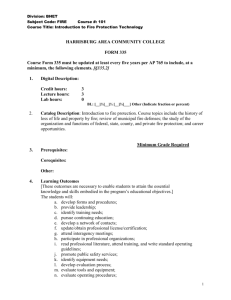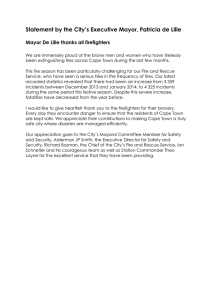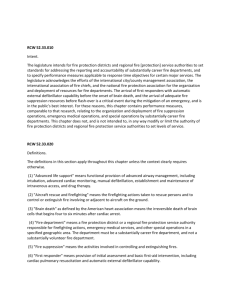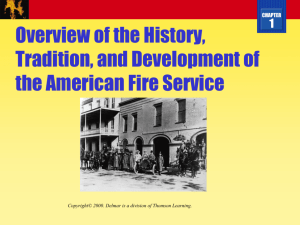Document 10465749
advertisement
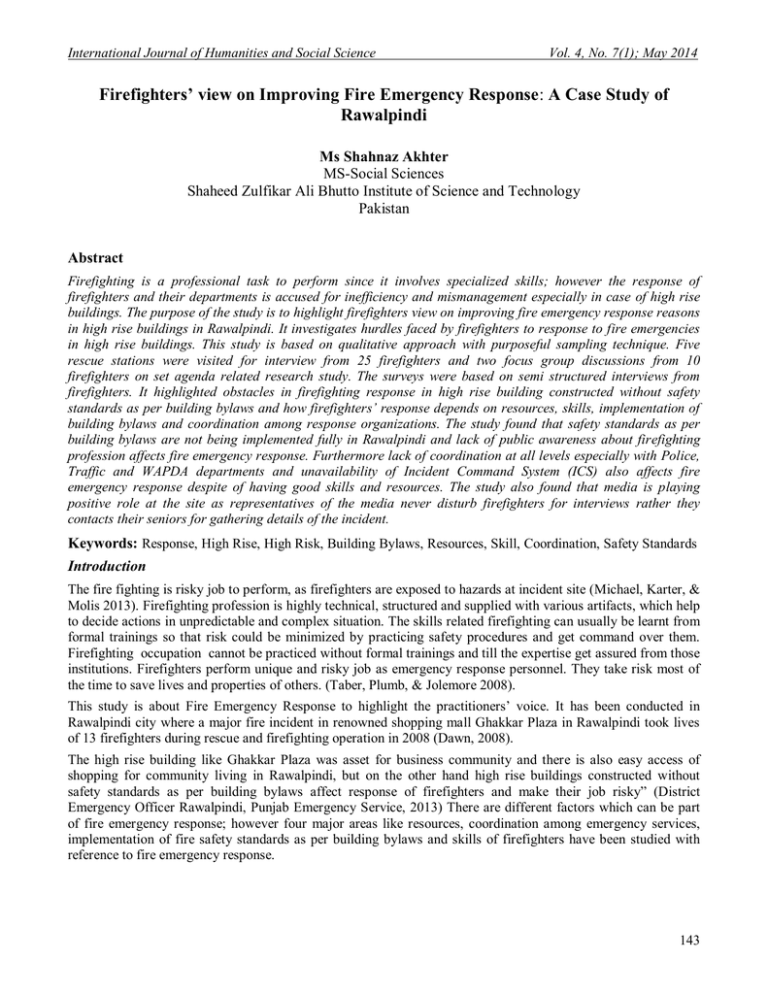
International Journal of Humanities and Social Science Vol. 4, No. 7(1); May 2014 Firefighters’ view on Improving Fire Emergency Response: A Case Study of Rawalpindi Ms Shahnaz Akhter MS-Social Sciences Shaheed Zulfikar Ali Bhutto Institute of Science and Technology Pakistan Abstract Firefighting is a professional task to perform since it involves specialized skills; however the response of firefighters and their departments is accused for inefficiency and mismanagement especially in case of high rise buildings. The purpose of the study is to highlight firefighters view on improving fire emergency response reasons in high rise buildings in Rawalpindi. It investigates hurdles faced by firefighters to response to fire emergencies in high rise buildings. This study is based on qualitative approach with purposeful sampling technique. Five rescue stations were visited for interview from 25 firefighters and two focus group discussions from 10 firefighters on set agenda related research study. The surveys were based on semi structured interviews from firefighters. It highlighted obstacles in firefighting response in high rise building constructed without safety standards as per building bylaws and how firefighters’ response depends on resources, skills, implementation of building bylaws and coordination among response organizations. The study found that safety standards as per building bylaws are not being implemented fully in Rawalpindi and lack of public awareness about firefighting profession affects fire emergency response. Furthermore lack of coordination at all levels especially with Police, Traffic and WAPDA departments and unavailability of Incident Command System (ICS) also affects fire emergency response despite of having good skills and resources. The study also found that media is playing positive role at the site as representatives of the media never disturb firefighters for interviews rather they contacts their seniors for gathering details of the incident. Keywords: Response, High Rise, High Risk, Building Bylaws, Resources, Skill, Coordination, Safety Standards Introduction The fire fighting is risky job to perform, as firefighters are exposed to hazards at incident site (Michael, Karter, & Molis 2013). Firefighting profession is highly technical, structured and supplied with various artifacts, which help to decide actions in unpredictable and complex situation. The skills related firefighting can usually be learnt from formal trainings so that risk could be minimized by practicing safety procedures and get command over them. Firefighting occupation cannot be practiced without formal trainings and till the expertise get assured from those institutions. Firefighters perform unique and risky job as emergency response personnel. They take risk most of the time to save lives and properties of others. (Taber, Plumb, & Jolemore 2008). This study is about Fire Emergency Response to highlight the practitioners’ voice. It has been conducted in Rawalpindi city where a major fire incident in renowned shopping mall Ghakkar Plaza in Rawalpindi took lives of 13 firefighters during rescue and firefighting operation in 2008 (Dawn, 2008). The high rise building like Ghakkar Plaza was asset for business community and there is also easy access of shopping for community living in Rawalpindi, but on the other hand high rise buildings constructed without safety standards as per building bylaws affect response of firefighters and make their job risky” (District Emergency Officer Rawalpindi, Punjab Emergency Service, 2013) There are different factors which can be part of fire emergency response; however four major areas like resources, coordination among emergency services, implementation of fire safety standards as per building bylaws and skills of firefighters have been studied with reference to fire emergency response. 143 © Center for Promoting Ideas, USA www.ijhssnet.com Firefighter is a person who provides response in fire emergency with fire tenders along with all necessary equipment specially Self Contained Breathing Apparatus (SCBA) to enter in building, perform rescue activities and put off fire. The firefighter at fire engine is responsible to extinguish fire and prevent it from spreading, whereas firefighter at ladder trucks perform ventilation and rescue activities at incident and he also clears path for firefighters to enter at the upper part of the building. (Toups & Kerne, 2007) The response means assistance provided by emergency services to ensure public safety, saving lives, reducing health impact and basic subsistence need for affected people (UNISDR, 2008)1, whereas coordination is an important component and challenging job in emergency response, which includes high assurance for quick decision making and response under high time pressure with limited resources and dealing with of multi authorities and different interest groups. (Chen, Sharman, Rao, & Upadhhyaya 2008) The building by laws is a set of standards which have been established by local government for structure of safety of building and high rise building refers to a structure of building above 38 feet (11.58m) (Rawalpindi Development Authority Government of Punjab, 2007) Besides coordination the study discussed resources (fire tenders along with all essentials equipment like fire hoses, nozzles, fireman axes, fire hook, fire breaching Inlet and outlet, extinguishing agent like water and Aqueous film forming foam (AFFF), personal protective equipment, communication equipment) and specialized vehicles for rescue and firefighting from height specialized skills of firefighters (includes scene assessment, access, locate and evacuate victims, extinguish fire according to nature of fire, restrict fire to spread, investigation cause of fire, providing first aid) fire safety standards as per building bylaws include (Emergency Exit, Emergency Evacuation Signs, Internal Hydrant System, External Hydrant System, Smoke alarm and Sprinkle System). (Rawalpindi Development Authority Government of Punjab, 2007) This study has been designed with qualitative approach and purposeful sampling. Semi Structured interviews and focus group discussions have been conducted to get data related four independent variables. It has been studied that how coordination affects professional work and how skills make confident related assigned task. Furthermore Implementation of Fire Safety Standards as per building bylaws is the need of hour to provide better fire emergency response resulting minimize loss of precious human lives and properties in fire emergencies in high rise buildings. Literature Review The history of fire and fire fighting started thousands years ago and fire incidents also took place. Many agencies, forces and groups had been established with the passage of time for fire fighting and rescuing people from loss of lives and properties in case of fire emergencies. According to the sources in the history, “the first ever fire fighting crew had been formed by Caesar to protect Rome against fire” (Singh, 2008). The first recorded major fire incident in the history of United States occurred at James Town in 1608 within a year of its establishment which left huge losses of life, property and money. Nonetheless, Boston city witnessed some major fire incidents with losses. The city experienced ravaging fires in 1630, 1631, 1654 and 1676 serving as eye opener for the administration to give a serious thought to fire fighting and fire prevention. Consequently, new courts and rules regarding fire fighting including laws pertaining to the usage of open spaces and fire resistant building material were developed. Fire fighting departments were also established. These were the first ‘written’ rules pertaining to fire fighting and prevention (Singh, 2008). Similarly great fire of London September 1666 ruined many buildings included 13,200 houses, 87 churches and left many direct and indirect deaths. There was very basic knowledge and skills at that time and firefighters used basic resources like leather buckets, axes and water squirts which had left little effect on fire. As a result London city had to be totally reconstructed (Whitehall, 1666). Quite recently, the major terrorist attack in New York City and Washington DC witnessed the Fire departments as the Primary first responders. Although the local responders orchestrated the immediate rescue efforts, their resources were strained. The emergency responders encountered many of the same problems that are experienced during catastrophic disasters. Communication system failed 911 call centers were overwhelmed, trained personnel were in short supply interagency communication was lacking or absent altogether, response plans were often ignored and widely thought to be inadequate, interagency chains of command were often ambiguous and more than 300 firefighters lost their lives while responding to attack on the world Trade Center (The 9/11 Commission Report, W.W. Nortan & Company, 281). 144 International Journal of Humanities and Social Science Vol. 4, No. 7(1); May 2014 Similarly, the loss of precious lives on 3rd May, 2013 “West fertilizer co explosion” places a question-mark on the effectiveness of fire fighting departments and their preparedness. It is pertinent to note that many of the life losses were of first responders or voluntary fire fighters. (Simon, 2013) Firefighting is tough and volatile work to perform. Firefighters described this work as an “organized chaos”. They are very much proactive regardless of their training and experience in field of firefighting. Firefighters do not take any emergency call as routine emergency call due to unpredictable scenario on each fire emergency. The firefighters perform their work through a framework known as Incident Command System (ICS), which helps them to deal with different scale of emergencies and manage them in an effective way. Through Incident Command System (ICS) managers from other departments included in decision making know importance of firefighting as well as their role and responsibility in case of fire emergencies. (Taber, Plumb & Jolemore 2008) Raja (2012) found in a survey that after major fire incidents Ghakhar Plaza on 20th December, 2008 in Rawalpindi in many incidents like Shangahi Plaza, China Market fire incident on 25th on June, 2009 , fire incident on Internal Women Day 8th March, 2010 in Girls hostel (six girls suffocated to death), fire incidents in Sabzi Mandi, Raja Bazar on 22nd October, Imperial Market, Raja bazaar (caused many Compact Disk Shops gutted) Toyota Motor warehouse fire at sowan camp on 30 April, 2012, Electronic Market fire at Afandi Colony on 19th June, 2012, fire incident at Ghee Mill Model Town, Humak on 22 nd June, 2012 caused heavy loss and highlighted firefighters efforts. He also referred to fire incident at Crown City Plaza caused two women faint. Raja (2012) found during survey interview from concerned authorities and occupants related problem faced by them. He highlighted that absence of firefighting measures is one of the major cause for great loss and making response difficult of firefighters. He further wrote that no emergency exits in the building are available, firefighting organization Rescue 1122 also arranged training for 26 building inspectors of City District Government regarding installation of Fire Safety Standards in the building but even 153 industrial units were operational in residential area and high risk building are without necessary safety measures. Eftichidis (2007) also found absence of coordination in case of major disaster is a big reason of slow response to fire emergencies in Greece. Ideally, developed countries practices like USA are considered to be a benchmark in almost every sphere even emergency management. If, however, the fire fighting management is meager in World’s super power, where does a struggling nation-state like Pakistan stands? Nonetheless, Pakistan’s response to massive fire incidents in Shaheed-e-Millat Secretariat a multi story building in blue area Islamabad in 2002, Marriot Hotel Islamabad in 2008, Inferno, Garments factory baldiya town Karachi 2012, Ghakkar Plaza 2010, Lahore Development Authority (LDA), 2013 have been severely criticized by the media, whereas response agencies showed their concern over inaccessibility to the buildings for fire fighting and evacuation from multi storey buildings. The firefighters always try to take risk in all fire fighting operations and even in one of major incident in District Rawalpindi 13 firefighters scarified their lives in the line of the duty. (Dawn News, 2008). The major fire incident in renowned shopping mall (Ghakkar Plaza) in Rawalpindi city took lives of 13 firefighters during rescue and fire fighting operation in 2008. This was first incident in the history of Pakistan, where fire fighters lost their lives due to collapsed concrete structure. This incident highlighted factors affecting efficient response from fire fighting institutions, which have been long neglected in Pakistan. The high rise buildings like Ghakkar Plaza is asset for business community and there is also easy access of shopping for community living in Rawalpindi, but on other hand, high rise buildings constructed without safety measures as per building bylaws affect response of firefighters and make their job more risky. (Pakistan Observer, The News & Dawn 2011) The Nation newspaper published news on 24th September (2012) with reference to investigation of Karachi fire incident occurred in a garments factory, took lives of more than 270 people. The newspaper staff contacted National Expert on Fire Safety and Emergency Response, who told that such losses and poor response from firefighting institution is because of unavailability of National Fire and Safety Policy. The policy had been prepared by National Advisory Group, comprising of 26 experts and submitted to National Disaster Management Authority in 2010 after tiring efforts of 10 months. This policy draft discussed all details related to existing structure of organizations, buildings, problems related to fire emergencies in Pakistan with guaranteed solutions. Furthermore, this draft had been vetted by the Deputy Attorney General of Pakistan, but unfortunately it's still awaiting approval from concerned authority. 145 © Center for Promoting Ideas, USA www.ijhssnet.com The point of view of Expert on National Fire Safety Policy also highlights the importance of the National Fire and Safety Policy draft approval that will further demand to prepare Fire and Safety Act to have legal binding for building owners and business community. The legal binding will facilitate firefighting institution to plead against building bylaws violators and that legal threat to building’s owners can have positive effect on response to fire emergencies. Research Design This study has been conducted with qualitative approach based on purposeful sampling. The respondents were firefighters from five Rescue Stations of Rawalpindi City. The respondents were designated Fire Rescuer (FR) and Lead Fire Rescuer (LFR) working at five Rescue Stations. Lead Fire Rescuers are one scale senior to Fire Rescuers. Interviews based data analysis helped to set an agenda for further two focus group discussions. The researcher kept in consideration research ethics as followed in interviews related convenience for participation, consent, trust etc. Incident Command System (ICS) and Role of Media at Incident site have been included in main set of research area like resources, coordination, skills and implementation of fire safety standards as per building bylaws. The research tried to be more specific in Focus Group Discussions by starting discussion to prioritizing key issues in fire emergency response and also tell challenges behind and discuss tentative solutions. A group of five respondents participated in first group discussion and then another group discussion consisting of five respondents from second rescue stations have been arranged to reach the conclusion. Area of the Study The area of the study is Emergency Response in the field of firefighting. In this regard fire fighters from five Rescue Stations situated at Rawal Road, Pir Wadahi More, Civil Lines, Bahria Town and Kalma Chowk have been selected for interviews and focus group discussions on basis of working experience in the field of firefighting in Rawalpindi City so that maximum information could be obtained from fire fighting practitioners for useful study analysis. Respondents Thirty Five designated firefighters were respondents of the study. Twenty five respondents from five rescue stations have been interviewed and 10 respondents have participated in two Focus Group Discussions. Each group was consisting of 5 research participants in Focus Group Discussions. Instrument / Technique of the Study The semi structured interviewed and focus group discussions have been conducted with purposeful sampling. A set of questions were also formulated to conduct semi structured interview and after interview from 25 respondents initial analysis has been done which helped to set agenda for two focus group discussions. Variables of the Study One dependent variable response and five independent variables resources, skill, building bylaws, coordination and Incident Command System (ICS) have been studied. Findings Prioritized Key Issues by Respondents The respondents’ prioritized key issues in Fire Emergency Response as caller’s half and wrong information or delay emergency call is the priority one step in fire emergency response The coordination with traffic to access the site, cut off electricity and stop sui gas to start the operation is the second step along with the availability of police at site to control crowd and law and order situation. The major problems faced by firefighters in the buildings are due to absence of buildings map and emergency exits, water sources that can be minimized by implementation of fire safety standards. The respondents also emphasized on coordination among Emergency Services for resource pulling and establishing Incident Command System (ICS) for fire emergency response and then resources and skills get works in high rise buildings. The respondents do not think that media is an obstacle in fire emergency response except representatives of media are at risk if enters in hot zone. Major Challenges The respondents’ elaborated causes of key issues in Fire Emergency Response as follows 146 International Journal of Humanities and Social Science Vol. 4, No. 7(1); May 2014 The 50 % respondents viewed that callers give half of information due to panic situation or lack of awareness about incident place resulting delay access at site. They also attempt to extinguish by themselves when emergency gets out of control they call at emergency number which affects fire emergency response. 90 % respondents commented that traffic control for emergency vehicles always remain a big issue. Mostly respondents identified that traffic issue is because of lack of education about traffic rules, unnecessary parking at main roads, media hype for incident and rushing everybody towards incident site, lack of coordination between traffic police and Emergency Service, unavailability of emergency track in road infrastructure and single road with two way traffic. The 100 % respondents expressed that unavailability of Police is the major cause for Crowd Control and public interruption. Regarding absence of buildings maps at entrance 95% respondents said that building related authorities have lack of control on encroachment and their own staff is lacking awareness related fire safety standards. Furthermore the study also found that building authorities neither inspect buildings after construction on quarterly or yearly basis nor get vacated when estimated age of building complete. The hundred percent respondents said that coordination is an integral part of fire emergency response and its lacking among emergency response organizations due to lack of information about their quick role in case of emergencies. The 70 % respondents highlighted that in case of major emergencies they found their seniors at Incident Command Post (ICP) but seniors from other organizations do not stay at site more than 10 to 15 minutes, resulting coordination gap and suffering effectiveness of Fire Emergency Response. The study found that ninety 95 % respondents are satisfied with the skills and steps taken by their organization to improve with the passage of time. Resources according to responders are very important but 95 % found satisfied from their resources and provided two to three suggestions for improvement mentioned in next portion. Recommendations for Future The respondents suggested following measures for improving Fire Emergency Response which are somehow related to literature reviewed of the study. Chow and Tusi (2004) found that provision of fire safety is associated with proper implementation of fire safety management. This research also found that implementation of fire safety standards in high rise buildings can provide safety to occupants and minimize firefighters’ risk for which neutral Building Control Authority is recommended to avoid favoritism and ensure proper implementation of fire safety standards as per building bylaws. Fire Safety Standards as per building bylaws must be implemented in new buildings as found same problem in Hong Kong and author Chow and Tusi (2004) suggested formulation of clear fire safety plan with clear responsibility for undertaking management responsibilities. In Rawalpindi old building should have at least emergency staircase to access the building and overhead source of water for provision of water at site as per notification issued from home department to all concerned departments of Punjab. Factories may be shifted to open areas instead of residential area. Building owners should be sensitized related importance of installation of fire safety measures in the buildings. Raja (2012) also suggested that strict implementation of fire safety standards is required to reduce losses of lives in high rise buildings and firefighters can perform their job easily. Coordination among services in peace time may be improved through joint drills, mock exercises that will help in real emergency scenario. Coordination Cell in major incidents may be established for executing real Incident Command System (ICS) where senior representatives from emergency response organizations like Rescue 1122, Police, WASA, WAPDA, Sui Gas Representative of City District Government, Cantonment, Rawalpindi Development Authority and Tehsil Municipal Administration should be present till completion of Fire Emergency Response. Same found during literature reviewed that Salmon, Stanton, Jenkins and Walker (2011) also suggested regular multi agencies training exercises in peace time for improving coordination and establishing incident Command System at various level includes gold, silver and bronze. 147 © Center for Promoting Ideas, USA www.ijhssnet.com Traffic rules needs to be strictly implemented and unnecessary parking at main roads should be fined. Police should be activated with serious notice to cordon off area, control crowd and public interference. The coordination among emergency response organizations may be improved for fire emergency response. These findings prove Hypothesis 4 that increases in coordination among emergency services is essential for fire emergency response. Good practices for enhancement of skills found in study like conducting refreshers and advance courses, physical fitness tests, yearly competition mock exercises and drills were emphasized to be continued with addition to get to gathers parties between firefighters of different rescue stations after three months. Lo and Yuen (2000) also highlighted importance of training because background of professionals due to trainings helps to understand in priority setting related safety standards in buildings. Public Awareness about firefighting profession and their role in case of emergency, exact information about location, incident and Fire Safety may be included in school curriculum and media campaign. Extensive media campaign should be launched for Fire Safety by the Government and media should not be allowed to enter in red zone of emergency but proper information may be provided to them from Incident Command Post (ICP). Air Purification Respirators (APR) Masks, Fire Extinguishers of 25 Kg and quick fire bike along with extinguishing agent may be added in firefighting equipment for rapid response in vehicles fire and transformers. Repair work needs to be speed up related fire emergency resources. Contribution of this Study This study contributed to highlight the importance of firefighting profession in general and particularly fire emergency response problems with reference to Rawalpindi. This study can be used as reference study for implementation of fire safety standards in high rise buildings, formulating coordination strategy at all levels and awareness of public through media and curriculum. Conclusion Firefighting is a specialized job which requires professional knowledge, training, skills and resources with professional working understating among emergency services and community. The fire emergency response can be improved through coordination, ongoing enhancement of skills of firefighters, establishing incident command system, timely provision of resources, in time repair of equipment, community awareness through media, Community education through safety curriculum and implementation of fire safety standards in buildings. References 2013, About us. Retrieved from http://www.ndma.gov.pk/new/aboutus/aboutus.php Asghar, M., (2004, December, 23). Contonment board orders Gahkar Plaza’s demolition. Dawn Islamabad. (The) Brookings Institution, Centre for Public Policy Education (2005) The Mega Fire Phenomenon: Toward a More Effective Management Model, The Brookings Institution, Center for Policy Education, Washington DC, 20 September Bassi, S. And Kettunen, M. (2008) Forest Fires: Causes and Contributing Factors in Europe, Policy Department Study, European Parliament, Brussels, February. Blaikie,P.,Cannon, T., Davis, I. And Wisner, B. (1994), At Risk. Natural Hazards, People's Vulnerability and Disaster, Rout ledge, London. Chen, R., Sharman, R., Rao, R. H., & Upadhhyaya, S. J. (). Chicago High Rise Safety Commission (CHRSC) (1999), High Fire Safety: Problems and Solutions, Chicago High Rise Safety Commission (CHRSC), Chicago, IL. Childs, M.(2005). Beyond training: new firefighters and critical reflection. Disaster Prevention and Management, 14(4) pp. 558-556. Chow, W.K., & Lui, G.C.H. (2002). Fire safety facilities assessment for karaokes, 20(13-14), pp. 441-449. Communities and Local Government (2006),”Fire and resilience”, available at : www.communities .gov.uk/fire/(accessed 12 January 2008). Emergency Service Performance Report. (2009). Punjab Emergency Service, Lahore. pp. 4-5. Evenson,G (1998), “Cutting your losses in a high-rise building fire”, Risk Management, Vol. 35 No.7, pp.24-33. 148 International Journal of Humanities and Social Science Vol. 4, No. 7(1); May 2014 Federal Emergency Management Agency (FEMA) (2008), US Fire Administration-Residential Structure and building Fires, Federal Emergency Management Agency (FEMA), Washington, DC, pp.1-20. Federal Emergency Management Authority (FEMA) (2008) “FEMA strategic Plan fiscal years 2008-2013” at: www.fema.gov/pdf/about/fy08_fema_sp_bookmarked. pdf (23 june, 2010). Fire Research Report (2000), Where in New Zealand have Fatal Domestic Fires Occurred? University of Otago Research Team, Dunedin, PP. 1-9. Japan International Cooperation Agency (JICA) (2008),”The study On Water supply and sewerage system in Karachi in the Islamic Republic of Pakistan”, Draft final report, Japan International Cooperation Agency (JICA), Karachi, Vol. 2, pp. 6.1-6.17. Hassanain M. A.(2009). On the challenges of evacuation and rescue operations in high-rise buildings. Disaster Prevention and Management, 27(2) pp. 109-118. Implications for Teaching Fire Emergency Responders. Kumpulainen , S. (2006)” Vulnerability concepts in Hazards and Risk assessment ”In Schmidt Thome,P.(Ed), Natural and technological Hazards and Risks in European Regions, Special Paper 42, Geological Survey of Finland Espoo,pp. 65-70. Lo, S.M., Lam, K.C., & Yuen, R.K.K. (2000). View of building surveyors and building services engineers on priority setting of fire safety attributes for building maintenance 79(13/14) pp. 526-523. Maditinos, Z., & Vassiliadis, C.(2011). Mega Fire : can they be managed effectively?. Disaster Prevention and Management, 21(1) pp. 41-52. Meditatinos, Zissis & Vissiliadis Christos.,(2011) Disaster Prevention and Management University of Macedoia, Thessaloniki, “Greece.” Mega Fires: can they be managed effectively? Muhamamd A. Hussanain , Kindg Fahad University of Petroleum and Materials Dhahran, Saudi Arabia.” On the Challenges Of evacuation and rescue operations in high-rise buildings” National Fire Protection Association (NFPA) (2010), Standards on Disaster/Emergency Management and Business Continuity Programs, NFPA, Quincy, MA. Rafi, M.M., Wasiuddin, S., & Siddiqui, H.S.(2012). Assessment of fire hazard in Pakistan. Disaster Prevention and Management, 21(1) pp. 71-81. Raja, M., (2012, December 29). Fire threats: New Ghakhar Plaza, 152 others play with flames. The Express Tribune. Rawalpindi Development Authority Building and Zoning Regulations. (2007). Rawalpindi, Pakistan: Government of Punjab. Salleh , N.H And Ahmed,A.G (2009),”fire safety management and risk heritage buildings: the current scenario in Malaysia”, Proceedings of 22nd CIPA Symposium in Kyoto, Japan, 11-15 October. Salmon, P., Satnton, N., Jekins, D., & Walker, G. (2011). Coordination during multi –agency emergency response: issue and solutions. Disaster Prevention and Management, 21(2) pp. 140-158. Shakil-ur-Rehman, M.(2008, December, 23). Up in smoke. The News Internation. Taber, N., Plumb, D., Jolemore, S., (2008). “Grey” areas and organized chaos” in emergency response. 20. pp. 272-285. Toups, Z.O., & Kerne, A., (2007). Implicit Coordination in Firefighting Practice: Design Tsui, S.G., & Chow, W.K.(2004). Legislation aspects of fire safety management in Hong Kong.22(5-6) pp. 149164. US Fire Administration (2002).” Topical Fire Research Series, Vol. 2 No. 18 , January, National Fire Data Center, Emmetsburg. MD. Wagner, S.L., (2011). Factor Analytic structure of the impact of Events Scale – Revised when used with a firefighting sample. Disaster Prevention and Management, 20(5) pp. 473-484. Wild land Fire Lessons Learned Centre (2007), Southern California Fires 2007: What We Learned, How We Worked, Initial Impression Report, Wild Land Fire Lesson Learned Center, Tuscon, AZ. 149

